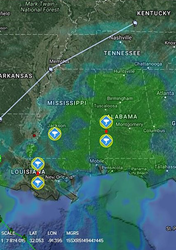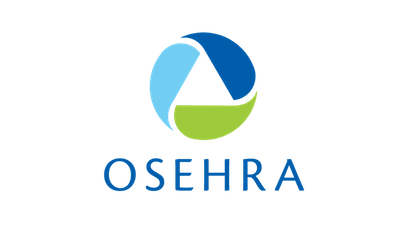US Department of Homeland Security (DHS)
See the following -
Kaazing Unveils DisasterAWARE ENTERPRISE™ Real Time Risk Intelligence Platform For Businesses Worldwide
 With new records being set each year for natural disaster losses, enterprises face an ever-increasing need to be prepared. For decades, DisasterAWARE has served the needs of top agencies worldwide, including U.S. Department of Defense, Homeland Security FEMA, the United Nations, the Association of Southeast Asian Nations (ASEAN), and a variety of international humanitarian aid organizations. With over 1.7 million users of DisasterAWARE mobile app, Disaster Alert for the public, spanning 115 international organizations, Kaazing is helping to broaden the reach of this critical, life-saving technology to provide businesses with an enterprise-grade solution.
With new records being set each year for natural disaster losses, enterprises face an ever-increasing need to be prepared. For decades, DisasterAWARE has served the needs of top agencies worldwide, including U.S. Department of Defense, Homeland Security FEMA, the United Nations, the Association of Southeast Asian Nations (ASEAN), and a variety of international humanitarian aid organizations. With over 1.7 million users of DisasterAWARE mobile app, Disaster Alert for the public, spanning 115 international organizations, Kaazing is helping to broaden the reach of this critical, life-saving technology to provide businesses with an enterprise-grade solution.
- Login to post comments
Clade X pandemic exercise highlights policies needed to prevent or reduce the worst possible outcomes in future pandemics
 The outbreak of a moderately contagious and moderately lethal novel pathogen precipitated a catastrophic end to the scenario in Clade X, the day-long pandemic tabletop exercise hosted by the Johns Hopkins Center for Health Security on May 15 in Washington, DC. Clade X simulated a series of National Security Council–convened meetings of 10 US government leaders, played by individuals prominent in the fields of national security or epidemic response. Their dialogue as the scenario unfolded addressed significant uncertainties in current prevention and response capabilities, hamstrung by policy challenges at the federal level.
The outbreak of a moderately contagious and moderately lethal novel pathogen precipitated a catastrophic end to the scenario in Clade X, the day-long pandemic tabletop exercise hosted by the Johns Hopkins Center for Health Security on May 15 in Washington, DC. Clade X simulated a series of National Security Council–convened meetings of 10 US government leaders, played by individuals prominent in the fields of national security or epidemic response. Their dialogue as the scenario unfolded addressed significant uncertainties in current prevention and response capabilities, hamstrung by policy challenges at the federal level.
- Login to post comments
Congress Passes Legislation Authorizing Critical Biodefense Programs
 The House yesterday passed the Pandemic and All-Hazards Preparedness and Advancing Innovation Act. The bill reauthorizes existing statute governing public health efforts at the Department of Health and Human Services. Additions made by the bill - some of which were recommended by the Blue Ribbon Study Panel on Biodefense - address biodetection, hospital preparedness, medical countermeasures and response. Many of these programs will enable HHS to better defend the nation against biological threats. Both chambers of Congress have passed the bill, and it will now go to President Trump for signature.
The House yesterday passed the Pandemic and All-Hazards Preparedness and Advancing Innovation Act. The bill reauthorizes existing statute governing public health efforts at the Department of Health and Human Services. Additions made by the bill - some of which were recommended by the Blue Ribbon Study Panel on Biodefense - address biodetection, hospital preparedness, medical countermeasures and response. Many of these programs will enable HHS to better defend the nation against biological threats. Both chambers of Congress have passed the bill, and it will now go to President Trump for signature.
- Login to post comments
Congress Stepping in After Reorganizations, Leadership Vacuum Leave HHS Cybersecurity Center's Fate Unclear
 The Health and Human Services Department doesn’t want to talk about its Health Cybersecurity and Communications Integration Center. And that’s no surprise, since it doesn’t seem to know what to do with it, and no one who was responsible for standing it up is involved with it anymore. Lawmakers from the House Committee on Energy and Commerce and the Senate committee on Health, Education, Labor and Pensions sent a letter on June 5 to HHS Secretary Alex Azar pointing out some significant omissions in the department’s Cybersecurity Threat Preparedness Report, which the department is required to submit to Congress. The report is supposed to detail HHS’ responsibilities and preparedness to deal with cyber threats in health care.
The Health and Human Services Department doesn’t want to talk about its Health Cybersecurity and Communications Integration Center. And that’s no surprise, since it doesn’t seem to know what to do with it, and no one who was responsible for standing it up is involved with it anymore. Lawmakers from the House Committee on Energy and Commerce and the Senate committee on Health, Education, Labor and Pensions sent a letter on June 5 to HHS Secretary Alex Azar pointing out some significant omissions in the department’s Cybersecurity Threat Preparedness Report, which the department is required to submit to Congress. The report is supposed to detail HHS’ responsibilities and preparedness to deal with cyber threats in health care.
- Login to post comments
Daring to Defend the Federal Bureaucracy
In an age where “unelected bureaucrats” is a common Washington epithet, give credit to a law professor, former college president and experienced federal manager for cutting against the grain. “The need for a robust civil service has never been greater,” writes Paul R. Verkuil in Valuing Bureaucracy: The Case for Professional Government. “To be effective, government must be run by professional managers,” says the former president of William and Mary College who served five years in the Obama administration as chairman of the Administrative Conference of the United States...
- Login to post comments
How Secure Is Our Smart Grid?
Over the past several months, alarm bells have been going off regarding potential attacks against the U.S. electrical grid...In the [Department of Energy’s] landmark Quadrennial Energy Review, it warned that a widespread power outage caused by a cyberattack could undermine 'critical defense infrastructure' as well as much of the economy and place at risk the health and safety of millions of citizens. The report comes amid increased concern over cybersecurity risks as U.S. intelligence agencies say Russian hacking was aimed at influencing the 2016 presidential election”...
- Login to post comments
How Technology Can Help Mitigate Hurricane Harvey-Like Disasters
Unfortunately, we don’t yet have technology that can prevent a storm of the magnitude of Hurricane Harvey from devastating our cities and towns. But it can help in the response, and even provide valuable information for citizens trying to survive a catastrophic event. One key is properly locating backup and recovery systems for government agencies. Typically, most cities and towns with a backup plan for their data rely on nearby data centers. That’s fine if there is a fire at the local office building or something that forces the temporary closure of government buildings...
- Login to post comments
How The VA and UL Created an Orchestrated Approach to Healthcare Cybersecurity Assurance
 In today's high-risk Internet of Medical Things (IoMT) and cyber-warfare environment, one tool or individual line of cybersecurity solutions would likely not be able to satisfy the requirements for security and safety put forth by an HDO; hence, the aggregation of solutions branded as MedFusion was derived. The VA UL CRADA discovered that healthcare is strengthened in terms of security and safety of connectable medical devices through in-depth cybersecurity defense...Learning from the VA and UL cybersecurity research results, with respect to product-level management of vulnerabilities and threats to medical devices and their associated software algorithms, we can impact the quality of adoption of electronic health records and other data collection systems connected to the IoMT and consumers...
In today's high-risk Internet of Medical Things (IoMT) and cyber-warfare environment, one tool or individual line of cybersecurity solutions would likely not be able to satisfy the requirements for security and safety put forth by an HDO; hence, the aggregation of solutions branded as MedFusion was derived. The VA UL CRADA discovered that healthcare is strengthened in terms of security and safety of connectable medical devices through in-depth cybersecurity defense...Learning from the VA and UL cybersecurity research results, with respect to product-level management of vulnerabilities and threats to medical devices and their associated software algorithms, we can impact the quality of adoption of electronic health records and other data collection systems connected to the IoMT and consumers...
- Login to post comments
It Takes Years To Fully Recover From Big Storms Like Sandy
 The 2012 hurricane widely known as Superstorm Sandy left at least an estimated 325,000 New Jersey homes damaged or destroyed. Nearly seven years later, many of the New Jersey residents who have not fully recovered have to fend for themselves. The government funding has mostly dried up. Only two nonprofits that help survivors remain engaged...While researching the recovery efforts after Sandy, I have found that up to a third of the 2.5 million people who live in Keansburg, Belmar, Toms River and other places along the New Jersey coastline and back bays struck by the storm had not fully recovered from this disaster by October 2017 - five years later. Today, almost seven years after the storm, a lack of data and the patchwork of assistance programs make it difficult to fully assess what remains to be done.
The 2012 hurricane widely known as Superstorm Sandy left at least an estimated 325,000 New Jersey homes damaged or destroyed. Nearly seven years later, many of the New Jersey residents who have not fully recovered have to fend for themselves. The government funding has mostly dried up. Only two nonprofits that help survivors remain engaged...While researching the recovery efforts after Sandy, I have found that up to a third of the 2.5 million people who live in Keansburg, Belmar, Toms River and other places along the New Jersey coastline and back bays struck by the storm had not fully recovered from this disaster by October 2017 - five years later. Today, almost seven years after the storm, a lack of data and the patchwork of assistance programs make it difficult to fully assess what remains to be done.
- Login to post comments
Open Source Resources for major Disaster & Emergency Management Situations
 As everyone knows by now, the superstorm known as 'Hurricane Sandy' has caused considerable devastation across the East Coast of the United States and all the way up to the Great Lakes region. The effects of the storm will continue to be felt for days and weeks as major portions of the East Coast are without electricity and flooding is expected to continue for days. Under these circumstances, it seemed appropriate to put together a listing of open source applications that have been successfully used in emergencies and disaster recovery all over the world. In times of man-made crises or natural disasters, there is a range of organizations, websites, open source tools, mobile apps, and more that might be of use to first responders and citizens in general. Check out some of the following resources...
As everyone knows by now, the superstorm known as 'Hurricane Sandy' has caused considerable devastation across the East Coast of the United States and all the way up to the Great Lakes region. The effects of the storm will continue to be felt for days and weeks as major portions of the East Coast are without electricity and flooding is expected to continue for days. Under these circumstances, it seemed appropriate to put together a listing of open source applications that have been successfully used in emergencies and disaster recovery all over the world. In times of man-made crises or natural disasters, there is a range of organizations, websites, open source tools, mobile apps, and more that might be of use to first responders and citizens in general. Check out some of the following resources...
- Login to post comments
OSEHRA 2018: Perspecta Sponsors Open Source EHR Summit
 OSEHRA is delighted to welcome Perspecta as the Conference Sponsor for our 7th Annual Open Source Summit, to be held this July 18 – 20, 2018. Officially launched less than a week ago on June 1st, Perspecta was formed through a merger of the U.S. Public Sector Business of DXC Technology with Vencore Holding Corporation and KeyPoint Government Solutions. Those of you who follow the industry know that DXC Technology was the result of a massive merger of Computer Sciences Corporation (CSC) and HP Enterprise Services (which also included EDS). So, while the name is new, Perspecta will bring a wealth of experience (and yes, perspective!) to this year’s event.
OSEHRA is delighted to welcome Perspecta as the Conference Sponsor for our 7th Annual Open Source Summit, to be held this July 18 – 20, 2018. Officially launched less than a week ago on June 1st, Perspecta was formed through a merger of the U.S. Public Sector Business of DXC Technology with Vencore Holding Corporation and KeyPoint Government Solutions. Those of you who follow the industry know that DXC Technology was the result of a massive merger of Computer Sciences Corporation (CSC) and HP Enterprise Services (which also included EDS). So, while the name is new, Perspecta will bring a wealth of experience (and yes, perspective!) to this year’s event.
- Login to post comments
OSEHRA 2019 Summit Dates Announced
 Open Source Electronic Health Record Alliance (OSEHRA) is pleased to announce its 8th Annual Open Source Summit: Open SaaS - Open Source in the Cloud from Tuesday, July 9 through Wednesday, July 10, 2019 at the Bethesda North Marriott Hotel and Conference Center, just north of Washington, D.C. This year's two-day Summit will showcase leading-edge, open source initiatives and highlight the increasing level of public-private partnership in major programs and agencies. Open source software has become key to both implementation and interoperability as more and more programs opt for cloud-based solutions and software-as-a-service delivery models. This Summit will address ways to optimize open source utilization and community involvement in this new playing field.
Open Source Electronic Health Record Alliance (OSEHRA) is pleased to announce its 8th Annual Open Source Summit: Open SaaS - Open Source in the Cloud from Tuesday, July 9 through Wednesday, July 10, 2019 at the Bethesda North Marriott Hotel and Conference Center, just north of Washington, D.C. This year's two-day Summit will showcase leading-edge, open source initiatives and highlight the increasing level of public-private partnership in major programs and agencies. Open source software has become key to both implementation and interoperability as more and more programs opt for cloud-based solutions and software-as-a-service delivery models. This Summit will address ways to optimize open source utilization and community involvement in this new playing field.
- Login to post comments
OSEHRA 2019 Summit in Washington to Examine Next Steps for Open Health
 The Open Source Electronic Health Record Alliance (OSEHRA) will be holding its 8th Annual Open Source Summit at the Bethesda North Marriott Hotel and Conference Center. The theme of this year's two-day Summit is "Open SaaS - Open Source in the Cloud," this year's two-day Summit will showcase leading-edge, open source initiatives and highlight the increasing level of public-private partnership in major programs and agencies. Open source software has become key to both implementation and interoperability as more and more programs opt for cloud-based solutions and software-as-a-service delivery models. This Summit will address ways to optimize open source utilization and community involvement in this new playing field.
The Open Source Electronic Health Record Alliance (OSEHRA) will be holding its 8th Annual Open Source Summit at the Bethesda North Marriott Hotel and Conference Center. The theme of this year's two-day Summit is "Open SaaS - Open Source in the Cloud," this year's two-day Summit will showcase leading-edge, open source initiatives and highlight the increasing level of public-private partnership in major programs and agencies. Open source software has become key to both implementation and interoperability as more and more programs opt for cloud-based solutions and software-as-a-service delivery models. This Summit will address ways to optimize open source utilization and community involvement in this new playing field.
- The Future Is Open
- Login to post comments
Pandemic and all-hazards preparedness, response law emboldens U.S. disaster recovery efforts
 The Pandemic and All-Hazards Preparedness and Advancing (PAHPA) Innovation Act, S. 1379, became law on Monday with the president's signature, prompting accolades from national stakeholders, company executives and federal lawmakers. The far-reaching law ensures the United States will be better prepared to respond to a wide range of public health emergencies, whether man-made or occurring through a natural disaster or infectious disease. Overall, the law aims to bolster the nation's health security strategy, strengthen the country's emergency response workforce, prioritize a threat-based approach, and increase communication across the advanced research and development of medical countermeasures (MCMs), among numerous provisions contained in the law.
The Pandemic and All-Hazards Preparedness and Advancing (PAHPA) Innovation Act, S. 1379, became law on Monday with the president's signature, prompting accolades from national stakeholders, company executives and federal lawmakers. The far-reaching law ensures the United States will be better prepared to respond to a wide range of public health emergencies, whether man-made or occurring through a natural disaster or infectious disease. Overall, the law aims to bolster the nation's health security strategy, strengthen the country's emergency response workforce, prioritize a threat-based approach, and increase communication across the advanced research and development of medical countermeasures (MCMs), among numerous provisions contained in the law.
- Login to post comments
The Secret History of FEMA
FEMA gets no respect. Consider: The two men who are supposed to be helping run the federal government’s disaster response agency had a pretty quiet late August. Even as a once-in-a-thousand-year storm barreled into Houston, these two veterans of disaster response—Daniel A. Craig and Daniel J. Kaniewski—found themselves sitting on their hands. Both had been nominated as deputy administrators in July, but Congress went on its long August recess without taking action on either selection—despite the fact that both are eminently qualified for the jobs.
- Login to post comments